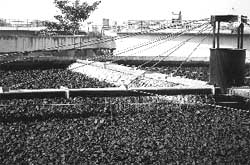Change at last
Change at last

an independent study of the Ganga Action Plan (gap), Cost benefit analysis of Ganga Action Plan, says that gap has in fact led to some improvement in the overall water quality of the Ganga. The study was supervised by Metroeconomica, a uk -based research group.
"The study shows that the Ganga has shown varying results, with some improvement noted," said Anil Markandya who is with the University of Bath, uk, and is involved in this analysis. This was the first time that a cost benefit analysis has been attempted, for any river cleaning programme in the world, said Markandya at a day-long workshop held at Delhi recently. He said that river-cleaning projects the world-over have achieved positive results, as in the cases of Thames, the Rhine and the Danube.. But these had been undertaken over much longer periods and with bigger investments.
The study dealt with the costs involved in the gap , its user and non-user benefits, health impacts, impact on waste-water toxicants and the consequent effects on agriculture, health and environment, fisheries and the biodiversity, along with the agricultural benefits and financial sustainability.
"The action taken has so far addressed 40 per cent of the waste effluent let out into the river," said K P Singh of the Industrial Toxicology Research Centre (itrc), Lucknow, which had studied the impact of gap on the waste-water toxicants. "Our studies indicate that the dissolved oxygen (do) and bio-chemical oxygen demand (bod) levels are better after the gap ," said Singh. The itrc studies show a marked decline of heavy metals and pesticide traces in Ganga water. When reminded that gap did not address agricultural run-offs, Singh pointed out that the erstwhile Ganga Project Directorate (gpd) had, in fact, issued notices to the ministry of agriculture to reduce certain persistent pesticides.
K J Nath, director of Calcutta-based All India Institute of Hygiene and Public Health (aiihph), however, said that their studies indicated that the bacteriological quality of the water had not improved. "The faecal coliform count hasn't shown much change. There is no evidence that morbidity has been reduced, post- gap ," said Nath. He cited the example of Kanpur, where the aiihph had not found any significant improvements in the water quality.
"The impact on biodiversity has been indirect," said R K Sinha of the Patna University who studied the impact of gap on biodiversity. "There has been an increase in the photoplankton and zooplankton presence in certain places, which would indicate that the water quality has improved," said Sinha. But he also noted that due to unavailability of data on lower invertebrates, the exact impact on biodiversity could not be assessed.
R A Gupta, principal scientist, Central Inland Capture Fisheries Research Institute (cifri), pointed out that in the post- gap period, there had been resurrection of some species of fish due to improvement in the water qua-lity. Curiously though, he added that their studies indicated some improvement in aquatic life at Kanpur, contradicting aiihph findings.
The results, however, has not satisfied the ministry of environment and forests (mef) officials present at the workshop. "We are not afraid of criticism," said Malti Sinha, additional secretary, mef. R P Sharma, advisor, National River Conservation Directo-rate, said that the study had not taken into account features, such as minimum flows while assessing the gap. Officials were also critical of the cost-benefit analysis of the study which surveyed non-users on payment to maintain a cleaner Ganga.







